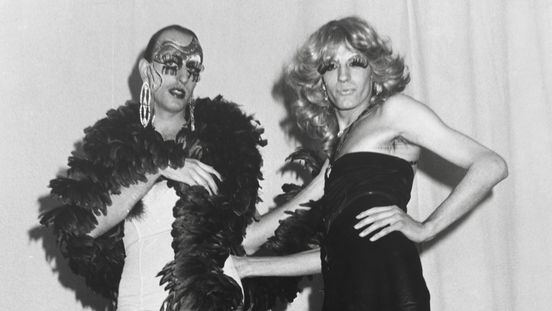When the curtain opens, women in brightly patterned dresses, accessorised with fans and jewellery, step into the deep red lounge bar. Because of their high-heeled shoes and false lashes, their Adam’s apples and broad shoulders – stereotypically masculine body features – are only noticeable on second glance. Men enjoyed appearing at Eldorado, a Berlin nightclub, in makeup with extravagantly styled short hair.
The three figures in the watercolour "Eldorado" embody an enticing interplay between the fetishisation of women’s clothing and the professional art of female impersonation (better known nowadays as drag). The relationship between drag and transvestism – in other words, between transformation and fetish – plays a significant role in gay entertainment to this day. Although the term 'transvestite' historically included transgender individuals, today it implies taking pleasure in wearing clothing associated with the other gender. “Drag Queens” usually view their appearances as a performative and provocative art practice. Both aspects came together in the cross-dressing of the 1920s and early 1930s.
As Berlin grew into a metropolis, the city became a magnet for many people who wished to escape the social pressures of the countryside. Despite the criminalisation of male homosexuality, these gay, lesbian and transgender people formed a multifaceted subculture with an unmistakable impact on the city’s public life. People compelled to lead double existences found longed-for safe spaces for 'sexual development' in the city’s nightlife. The two Eldorado dance clubs, touted as 'transvestite bars', were smashing successes from the start. Touring purportedly 'gay establishments' soon became a fashionable pastime. Art by queer performers increasingly turned into evening entertainment for a heterosexual audience. Curt Moreck praised the establishment in his 1930 "Guide to 'Depraved' Berlin" and points out: “The scenery [...] leaves one wondering: is it a man, a woman?” Berlin’s queer culture was framed as disreputable, but certainly interesting, and thus became a fascinating subject – even for heterosexual artists.
Otto Dix’s (1891–1969) interest in portraying the wildness of the urban jungle struck a rich vein in the voyeurism of Eldorado’s heterosexual audience. His chosen medium of watercolours was ideal for rapidly recording his impressions of the colourful bar.









